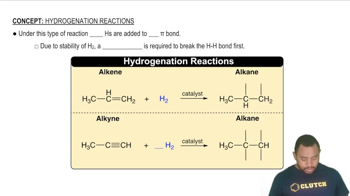Oil and water are immiscible. Which is the most likely reason? (a) Oil molecules are denser than water. (b) Oil molecules are composed mostly of carbon and hydrogen. (c) Oil molecules have higher molar masses than water. (d) Oil molecules have higher vapor pressures than water. (e) Oil molecules have higher boiling points than water.
Ch.13 - Properties of Solutions
Chapter 13, Problem 34a
Which of the following in each pair is likely to be more soluble in water: (a) cyclohexane (C6H12) or glucose (C6H12O6),
 Verified step by step guidance
Verified step by step guidance1
Identify the key structural differences between cyclohexane (C_6H_12) and glucose (C_6H_12O_6).
Recognize that cyclohexane is a nonpolar hydrocarbon, while glucose contains multiple hydroxyl (OH) groups, making it polar.
Recall the principle 'like dissolves like,' which suggests that polar substances are more soluble in polar solvents like water.
Consider the ability of glucose to form hydrogen bonds with water due to its hydroxyl groups, enhancing its solubility.
Conclude that glucose is likely to be more soluble in water than cyclohexane due to its polar nature and ability to hydrogen bond.

Verified video answer for a similar problem:
This video solution was recommended by our tutors as helpful for the problem above.
Video duration:
1mWas this helpful?
Key Concepts
Here are the essential concepts you must grasp in order to answer the question correctly.
Polarity and Solubility
Polarity refers to the distribution of electrical charge over the atoms in a molecule. Polar molecules, which have a significant difference in electronegativity between their atoms, tend to dissolve well in polar solvents like water. In contrast, nonpolar molecules do not interact favorably with polar solvents, leading to lower solubility.
Recommended video:
Guided course

Molecular Polarity
Hydrogen Bonding
Hydrogen bonding is a type of strong intermolecular attraction that occurs when hydrogen is bonded to highly electronegative atoms like oxygen or nitrogen. In the case of glucose, the presence of hydroxyl (-OH) groups allows it to form hydrogen bonds with water, significantly enhancing its solubility compared to nonpolar compounds like cyclohexane.
Recommended video:
Guided course

Hydrogenation Reactions
Molecular Structure and Functional Groups
The molecular structure and functional groups of a compound play a crucial role in determining its chemical properties, including solubility. Glucose contains multiple hydroxyl groups that increase its interaction with water, while cyclohexane, being a hydrocarbon with a ring structure, lacks polar functional groups, making it less soluble in water.
Recommended video:
Guided course

Functional Groups Example
Related Practice
Textbook Question
Textbook Question
Which of the following in each pair is likely to be more soluble in hexane, C6H14: (a) CCl4 or CaCl2, (b) benzene (C6H6) or glycerol, CH2(OH)CH(OH)CH2OH, (c) octanoic acid, CH3CH2CH2CH2CH2CH2CH2COOH, or acetic acid, CH3COOH? Explain your answer in each case.
1
views
Textbook Question
Which of the following in each pair is likely to be more soluble in water: (b) propionic acid (CH3CH2COOH) or sodium propionate (CH3CH2COONa)
Textbook Question
Which of the following in each pair is likely to be more soluble in water: (c) HCl or ethyl chloride (CH3CH2Cl)? Explain in each case.
Textbook Question
Indicate whether each statement is true or false: (c) As you cool a saturated solution from high temperature to low temperature, solids start to crystallize out of solution if you achieve a supersaturated solution.
